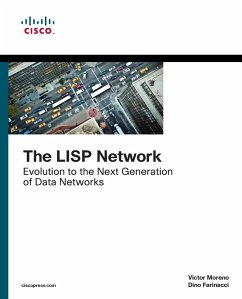The complete guide to seamless anytime/anywhere networking with LISP
In an era of ubiquitous clouds, virtualization, mobility, and the Internet of Things, information and resources must be accessible anytime, from anywhere. Connectivity to devices and workloads must be seamless even when people move, and their location must be fully independent of device identity. The Locator/ID Separation Protocol (LISP) makes all this possible.
The LISP Network is the first comprehensive, in-depth guide to LISP concepts, architecture, techniques, behavior, and applications. Co-authored by LISP co-creator Dino Farinacci and Victor Moreno-co-developer of the Cisco LISP implementation-it will help you identify the opportunities and benefits of deploying LISP in any data center, campus and branch access, WAN edge, or service provider core network.
This largely implementation-agnostic guide will be valuable to architects, engineers, consultants, technical sales professionals, and senior IT professionals in any largescale network environment. The authors show how LISP overcomes key problems in large-scale networking, thoroughly introduce its key applications, guide you through designing real-world solutions, and present detailed deployment case studies based on their pioneering experience.
· Understand LISP's core principles, history, motivation, and applications
· Explore LISP's technical architecture, components, mechanisms, and workflows
· Use LISP to seamlessly deliver diverse network services and enable major advances in data center connectivity
· Improve mobility, network segmentation, and policy management
· Leverage software-defined WANs (SD-WANs) to efficiently move traffic from access to data center
· Evolve access networks to provide pervasive, mega-scale, high-density modern connectivity
· Integrate comprehensive security into the networking control and data plane, and learn how LISP infrastructure is protected against attacks
· Enforce access control policies, connection integrity, confidentiality for data in flight, and end-point anonymity
· Discover how LISP mobility mechanisms anticipate tomorrow's application use cases
In an era of ubiquitous clouds, virtualization, mobility, and the Internet of Things, information and resources must be accessible anytime, from anywhere. Connectivity to devices and workloads must be seamless even when people move, and their location must be fully independent of device identity. The Locator/ID Separation Protocol (LISP) makes all this possible.
The LISP Network is the first comprehensive, in-depth guide to LISP concepts, architecture, techniques, behavior, and applications. Co-authored by LISP co-creator Dino Farinacci and Victor Moreno-co-developer of the Cisco LISP implementation-it will help you identify the opportunities and benefits of deploying LISP in any data center, campus and branch access, WAN edge, or service provider core network.
This largely implementation-agnostic guide will be valuable to architects, engineers, consultants, technical sales professionals, and senior IT professionals in any largescale network environment. The authors show how LISP overcomes key problems in large-scale networking, thoroughly introduce its key applications, guide you through designing real-world solutions, and present detailed deployment case studies based on their pioneering experience.
· Understand LISP's core principles, history, motivation, and applications
· Explore LISP's technical architecture, components, mechanisms, and workflows
· Use LISP to seamlessly deliver diverse network services and enable major advances in data center connectivity
· Improve mobility, network segmentation, and policy management
· Leverage software-defined WANs (SD-WANs) to efficiently move traffic from access to data center
· Evolve access networks to provide pervasive, mega-scale, high-density modern connectivity
· Integrate comprehensive security into the networking control and data plane, and learn how LISP infrastructure is protected against attacks
· Enforce access control policies, connection integrity, confidentiality for data in flight, and end-point anonymity
· Discover how LISP mobility mechanisms anticipate tomorrow's application use cases
Dieser Download kann aus rechtlichen Gründen nur mit Rechnungsadresse in A, B, BG, CY, CZ, D, DK, EW, E, FIN, F, GR, HR, H, IRL, I, LT, L, LR, M, NL, PL, P, R, S, SLO, SK ausgeliefert werden.

